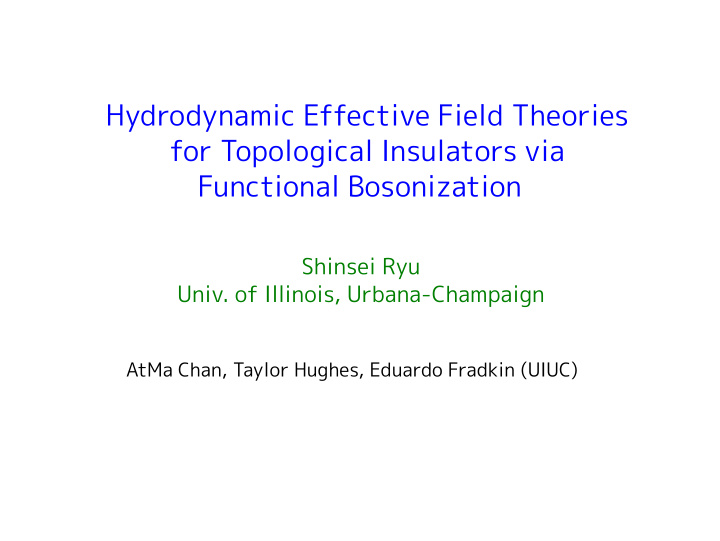



Hydrodynamic Effective Field Theories for Topological Insulators via Functional Bosonization Shinsei Ryu Univ. of Illinois, Urbana-Champaign AtMa Chan, Taylor Hughes, Eduardo Fradkin (UIUC)
Table of contents -- Introduction -- Functional bosonization (review) 1d Bose-Fermi correspondense 2d Trivial band insulator and duality 2d QHE and composite particle theories -- Topological insulators Integral topological insulator in 3d Z 2 topological insulators by dimensional reduction -- Interacting topological insulators -- Summary
Objectives: -- Goal: developing "hydrodynamic" theory of topological insulators (as opposed to effective field theory of response) [Cho-Moore (11), Vishwanath-Senthil (12) etc.] -- Motivations: - QH droplet can be understood as an incompressible liquid: Corresponding field theory: Chern-Simons theory - A clue for stability of topological insulator phases in the presence of weak interactions - A clue for the case where topological states arise from strong interactions "fractional topological insulator"
Effective "hydrodynamic" field theory of QHE Example: composite particle theories: [Zhang-Hansson-Kivelson, Jain, ...] Electron Statistical gauge field -- Flux attachement: Composite boson
Effective "hydrodynamic" field theory of QHE -- Boson-vortex duality: ( 0-form 1-form) dual gauge field -- Integrating over statistical gauge field:
Response theory of 3+1 d topological insulators -- Topological insulators: undeformable to atomic limit (topologically trivial state) under some symmetry conditions -- Characterized by anomalous ("topological") response E.g. magnetoelectric effect in 3D TR symmetric TI _ _ _ _ _ _ _ _ -- Response theory described by topological terms + + + + E.g. axion term + + + +
Functional bosonization recipe [Luther, Damgaard-Nielsen-Sollacher, Fradkin-Schaposnik, Burgess-Lutken-Quevedo, Banerjee (incomplete list)...]] -- Microscopic fermionic system: -- Interested only in conserved quantities: -- Making use of U(1) gauge invariance:
Functional bosonization recipe -- Hubbard-Stratnovich the pure gauge condition: -- Shift a --> a + A^{ex} -- Theory in terms of three fields: Bosonization rule:
functional bz in D=1+1 -- Applied to D=1+1d massive fermions ("1d topological insulator"): functional integral can be done exactly reproduces the bose-fermi correspondense. -- Applied to D=1+1d topological insulator: 1+1 d "BF" theory + "axion" term:
functional bz in D=2+1 -- Effective field theory of trivial insulator: BF theory w/o Chern-Simons term: with k = 1 -- Functional bz derivation of dual appoach to (band) insulators [Shindou-Imura-Ogata (06)] [Lee-Kivelson (03)] -- Theory is almost empty: no ground state degeneracy, no fermion, gapped edge state -- C.f. dual theory of BCS SC: [Hansson-Ognesyan-Sondhi (04)] (k = 2) BF theory at level 2:
functional bosonization in D=2+1 -- Effective field theory of Chern insulator BF theory with Chern-Simons: Ch=Chern number -- Functional bz derivation; alternative to composite particle theories [Schaposnik (95), Schaposnik-Fradkin (95), Berci-Oxman (00), Shizuya (01)] -- Theory is less empty: existence of fermions, gapless edge state, but no ground state degeneracy -- Equally applicable to QHE in continuum and Chern insulators on lattices.
Functional bosonization in D=3+1 -- 3+1d topological insulator with chiral symmetry ("class AIII") characterized by an integer topological invariant (physical realization: superconductor with conserved Sz) -- A microscopic lattice mode: [Hosur-Ryu-Vishwanath (10)] Kogut-Susskind staggered fermion + diagonal hopping
Effective field theory in D=3+1 -- Z[a]: -- Effective field theory BF theory with Axion term: -- Reproduces the axion resonse: -- Axion term "attaches" monopole to electron: -- Comparison with Cho-Moore story: See also [Vishwanath-Senthil (12)] Gauge transformation:
EM duality (S-duality) -- Maxwell theory -- Introduce monopole gauge field (u) and aux field (v) [Witten 1995] monopole gauge transf. -- Gauge away a: -- Integrate over u: -- Duality:
Integrating over "statistical" gauge field -- BF-Maxwell-Axion theory -- Introduce monopole gauge field (u) and aux field (v) -- Gauge away statistical gauge field (a) Integrate over u: -- Can gauge away v: "Higgs" or "Julia-Toulouse" Theory is written solely in terms of hydrodynamic gauge field, b.
Julia-Toulouse approach to defect condensation [Julia-Toulouse (79) -- Theory in "Coulomb" phase Quevedo-Trugenberger (97)] e.g. QED: KT: -- Theory after defect condensation: Here: : scale associated to condensation -- Basic idea behind:
Dimensional reduction -- Topological insulators with Z 2 topological invariants can be obtained from a higher dimensional system by dimensional reduction E.g. QSHE and 3D time-reversal symmetric topological insulators -- Effective field theory for response can be obtained by dimensional reduction [Qi-Hughes-Zhang (08) -- "Hydrodynamic" theory can also be derived by dimensional reduction -- Let's start from the "parent" theory in D=4+1d:
3D TR symmetric TI and QSHE -- Hydrodynamic field theory for 3+1d TR symmetric TI: bf coupling axion term -- Hydrodynamic field theory for 2+1d QSHE: -- Quantized responses can be derived from these theories.
fractional TIs ? -- Topological insulators beyond non-interacting systems: Recent numerics: Hubbard model with spin-orbit interactions on 3x4 cluster T-broken (FQH state) spin-orbit coupling T-unbroken (Topological) GS degeneracy fractional quantum spin Hall liquid interaction U/V [Neupert, Santos, SR, Chamon, Mudry, Phys. Rev. B 84, 165107 (2011)]
Parton construction -- A possible direction: parton construction - A way to generate model wfns with topological order - Edge theory: conformal embedding and coset construction [Zhang-Grover-Vishwanath (11)]
Blok-Wen parton construction -- Splitting an electron into (p+1) partons -- Functional Bz for free partons - Constraint - Effective field theories for partons in their QH states CS theory at level p+1 - In 2d FQHE, this construction (parton + func bz) is equivalent to composite particle theories (at least at this level).
Blok-Wen parton construction for general TIs -- Blok-Wen construction + hydro BF theories: E.g. k^3 ground state degeneracy on T^3 fractional magnetoelectric effect [See also Swingle-Barkeshli, McGreevy-Senthil, Maciejko-Qi-Karch-Zhang]
Summary - Functional bz derivation of hydrodynamic field theory of topological insulators. - Parton construction to get higher level k and fractional magnetoelectric effect - Other issues: Topological superconductors ? Other approach than partons to raise the level k.
Functional bosonization in D=4+1 --Can repeat the derivation for all dimensions, and all symmetry classes, as far as U(1) current is conserved For D=4+1, BF theory with 5D CS term at level 1:
Recommend
More recommend